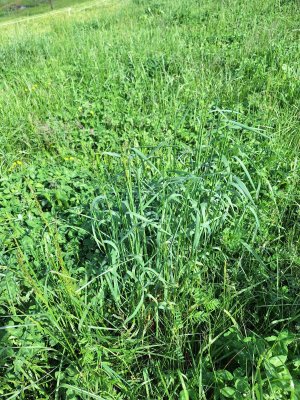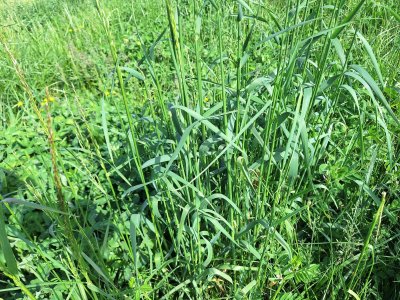In the past I thought this was a variety of fescue. I'm not sp sure that's accurate though. Different growth habit, seedheads have hairs/beard deal going on. It's a completely different color green. It's growing in random spots. Looks super healthy.
You are using an out of date browser. It may not display this or other websites correctly.
You should upgrade or use an alternative browser.
You should upgrade or use an alternative browser.
Grass ID
- Thread starter ClinchValley86
- Start date

Help Support CattleToday:
sim.-ang.king
Well-known member
Perineal ryegrass
Silver
Well-known member
Looks like quack to me.
coachg
Well-known member
What sim- Ang said
kenny thomas
Well-known member
Perennial Ryegrass is my first vote. Quackgrass is second. Both look very close after headed out.
Do we like it?Perennial Ryegrass is my first vote. Quackgrass is second. Both look very close after headed out.
kenny thomas
Well-known member
Cows eat it and makes hay if not over ripe.
After looking at pictures, I don't think it is perennial ryegrass nor quack grass. Has a seedhead very similar to fescue, only bearded.Cows eat it and makes hay if not over ripe.
I'll get some better picture. I'd really like to know. Haven't seem it before and there are quite a few little clumps of it this year. Gonna watch to see how hard the cows hit it. Should be to it by Thursday.
kenny thomas
Well-known member
It will disappear as soon as the cows go in. Just like Johnson grass you will never see it in continuous grazing because they keep it eat down.
Mark Reynolds
Well-known member
- Joined
- May 30, 2023
- Messages
- 888
- Reaction score
- 1,063
Haven't ID'd it yet, but definitely not perennial ryegrass.Perineal ryegrass
I'm wondering if it isn't a type of fescue. The bearded seed is what's throwing me for a loop.Haven't ID'd it yet, but definitely not perennial ryegrass.
Was dark when I got in last night, I'll grab a couple pieces of it to bring home for a photoshoot.
It's so green that it's almost blue.
Silver
Well-known member
Pl@ntNet seems to think its Elymus caninus:
Do you have bearded couch grass down there?
Elymus caninus (L.) L.167 122 observations
Bearded couch, Bearded wheatgrass, Fibrous wheatgrass, Awned wheat grass, Bearded couchgrass, Bearded Wheat Grass, Fibrous wheat grass, Fibrous-rooted wheat grass, Tufted couch, Bearded Wild Rye, Bearded couch-grass, Dog's Wheat
Do you have bearded couch grass down there?
Mark Reynolds
Well-known member
- Joined
- May 30, 2023
- Messages
- 888
- Reaction score
- 1,063
Many grasses have bearded variations so that is not out of the realm of possibility, and I think it is likely. That said, I'm probably more familiar with fescue than any other grass species and haven't encountered a bearded variation. But also, variations vary by region and I don't have experience with eastern TN. so.....
One very strong identifying feature I use for tall fescue is that, on somewhat more mature leaf blades, if you run your fingertips along the edge of the leaf blade from the leaf tip towards the base, the edge of the blade acts like/feels like it is ever so slightly serrated and you fingertips do not glide 'smoothly' towards the base. They encounter a 'rough resistance'.
One very strong identifying feature I use for tall fescue is that, on somewhat more mature leaf blades, if you run your fingertips along the edge of the leaf blade from the leaf tip towards the base, the edge of the blade acts like/feels like it is ever so slightly serrated and you fingertips do not glide 'smoothly' towards the base. They encounter a 'rough resistance'.
Mark Reynolds
Well-known member
- Joined
- May 30, 2023
- Messages
- 888
- Reaction score
- 1,063
Shouldn't be. Anything potentially is possible, especially if it would be a stray plant or two. Bou this, based on the description here, seems to be propagating itself and I definitely would not expect that of bearded wheatgrass in this location.Pl@ntNet seems to think its Elymus caninus:
Elymus caninus (L.) L.167 122 observations
Bearded couch, Bearded wheatgrass, Fibrous wheatgrass, Awned wheat grass, Bearded couchgrass, Bearded Wheat Grass, Fibrous wheat grass, Fibrous-rooted wheat grass, Tufted couch, Bearded Wild Rye, Bearded couch-grass, Dog's Wheat
Do you have bearded couch grass down there?
I went to get a few samples yesterday... I cannot locate a single clump. Lol.
When i do find it i will try the leaf underside for serations.
When i do find it i will try the leaf underside for serations.
Mark Reynolds
Well-known member
- Joined
- May 30, 2023
- Messages
- 888
- Reaction score
- 1,063
Leaf edge, not the underside. Basically, take a leaf blade and drag it across your fingertip kinda like using it like a knife. The leaf edge, but draw the leaf across your fingertip from the tip of the leaf to the base of the leaf, not the base of the leaf to the tip.I went to get a few samples yesterday... I cannot locate a single clump. Lol.
When i do find it i will try the leaf underside for serations.
Thanks for the explanation, Mark!Leaf edge, not the underside. Basically, take a leaf blade and drag it across your fingertip kinda like using it like a knife. The leaf edge, but draw the leaf across your fingertip from the tip of the leaf to the base of the leaf, not the base of the leaf to the tip.
kenny thomas
Well-known member
Lets see, didn't someone tell you it would be one of the first things to disappear when the cows found it? Who was that person?I went to get a few samples yesterday... I cannot locate a single clump. Lol.
When i do find it i will try the leaf underside for serations.
I think it was the supermodel with the scar on his nose.Lets see, didn't someone tell you it would be one of the first things to disappear when the cows found it? Who was that person?
kenny thomas
Well-known member
Thats the oneI think it was the supermodel with the scar on his nose.



